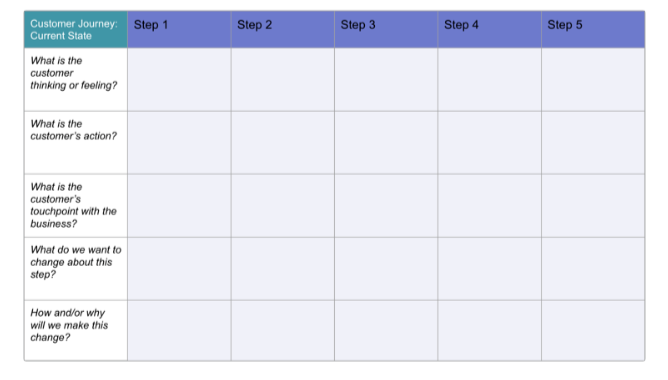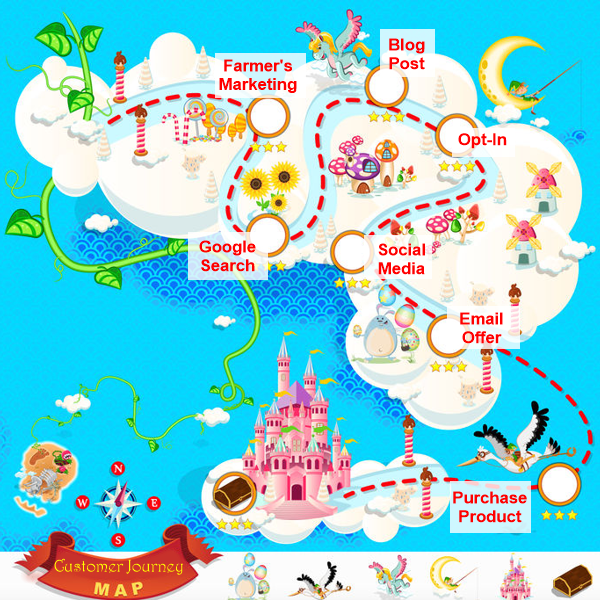The time they need you may not be the same time they’re ready to buy.
As a creative entrepreneur, your customer’s journey is different than anybody that creates courses, resells products online or markets other services.
You start out making products that you’ve taken to fairs, events or farmers market to sell.
As a maker, you have the benefit of actual face-to-face and eye contact during that first meeting with your customers… Or would-be customers.
You start with a simple hello. You asked if they’d like a sample.
Do they want to smell or feel or touch your products?

You can actually see where the customer journey starts, right there in front of you. However, most of the time you don’t see that or recognize that as a starting point for marketing.
Sure a customer journey may have also started online, maybe a Google search for products online…just to see what they can find.
Or, they head over to the local farmers market for the weekly shopping and discover you there.
It’s not your “typical” retail experience either. Your customers have a different driver, a different goal than just going to the mall, the boutique in town or even browsing on Amazon.
And, your data is going to look very different because farmer’s markets, artisan events and trade shows…don’t have analytics and customer data that you need for your marketing…as a creative entrepreneur.
This is where mapping out your customer journey will come in handy for developing a marketing strategy for growth.
WHY do you, as a creative entrepreneur, need a map like this?
The reason to map out your customer journey is to help make their experience seamless. They expect us to know who they are and what they like…or how they like to be treated throughout the buying process.
Your customers are also looking for a connected experience. They don’t want to be just a number…they can get that when they shop at any big box store. But with you, they want it personal.
As a small business owner, you have a great advantage here because you love knowing your customers and servicing them well.
Let’s map out that customer journey
I first want to point out that no two customers are the same, so no two maps are the same. But, with the information and data you gather, you can create a map that most of your customers will fit into.
First – what is the customer journey and why do we need to map it out?
A customer journey map helps crystallize where customers get stuck or frustrated on their path to purchase and beyond. It’s a visual representation that synthesizes data on personas and user behavior. (source: https://cxl.com/blog/customer-journey-maps/)
Knowing your customer’s journey will help you understand what they’re going through, from their point of view, and how they interact with you.
Second – why do you need to know this?
Well, we look at this journey and all the touchpoints your customer has had from the first time they see you and your product, to the first time they buy from you, and then become your loyal customer.
When you understand your customer’s behaviors and why they make decisions, it’s easier for you to create marketing messages that actually convert them into buyers. Your messages will mean something for your customers – rather than another piece of noise out in the marketplace.
And for makers…your customer journey map will look very different than an online business or service because you have touchpoints both in real-life and online.
Does their journey start when they discovered you at a farmer’s market, street fair or artisan show?
Did they get on your email list from there – actually writing out their email on a piece of paper for you to add to your crm later?
Or…did they see you, maybe sample a product or two, said thank you very much, grab a card and walked away? To then look up your website or find you on social media?
To start this journey you need to know
WHO your customers are
Who is your customer and what are their behaviors?
Yes, this is your customer avatar, your ideal client persona and so much more! This comes from actual customers you have engaged with, not an exercise in guessing what your ideal customer likes and doesn’t like because you actually know!
You can gather this data in a number of ways…surveys, interviews, customer emails, comments in forums and groups.
Here are some questions to ask:
How did you first hear about our company?
Did we first meet at an event? (Like a farmer’s market or trade show?)
What attracted you to our website?
What problems are you trying to solve and how can our company help you?
Have you ever bought anything from us? In-person or through our website?
On a scale from 1 – 10 (10 being the best) how easy was our website for you to navigate?
In creating your map there are 3 key stages to uncover your customer’s behavior
Awareness – what is their level of awareness of you, your brand and the type of product you sell.
Consideration – what’s going through their head as they consider a purchase?
Decision – how do they make their decisions…logically? Emotionally? What’s their process?
Hubspot has a few customer journey templates to check out. Here is one that works well for product makers.

With each stage ask these questions:
What are they thinking or feeling when it comes to buying products?
What action are they taking?
What are they researching and where are they getting their info?
How can you move your buyer along the journey…with you in mind?
What are your customer’s goals?
Once we know who they are we need to understand their goals – what do they hope to achieve during this journey. What problems do they need to solve? What desires do they want to see fulfilled?
When you understand this data and the goals of your customers you’ll be able to see if your website and marketing campaigns support them in their journey.
Next, what are the Touchpoints
This is where, and how many times, your customers engage and interact with you.
Touchpoints may start with in-person-events, social media or search. Are they reading your blog?
Touchpoints also include product descriptions, email campaigns, newsletters and paid advertising.
Where are they finding you and engaging with your information? Knowing this is a key piece to guiding your reader to a purchase that will fulfill their need as well as create your ongoing relationship.

Just as in copywriting, there are key pieces of information you need to know about your customers that will give you a better understanding of your buyers and help them make decisions along the way.
What Action are they taking? Are they opting into your email list? Are they opening your emails? Are they buying when you share on offer?
What Motivations and Desires do they have? What motivates them to act? To buy? Is it based on their desire for a better {you fill in the blank} or are they motivated by something else? Save or make money? Save time – get more done in less time? Travel? Family obligations?
How about any Obstacles and Pain Points? What issues or challenges are holding them back? What problems do they need to solve?
What is their current state – how are they feeling now? (No, not the geographical state they live in.) How are they feeling currently? What thoughts are going through their head? Motivations, desires, obstacles and pain points will help you identify their current state.
Their future state – how do they want to feel? What do they want to be/what transformation do they want?
As you move with your customers along this journey, you will uncover insights that will not only help you create products that serve your customer’s needs, but you’ll be able to “talk” to them through your marketing messages.
Those messages will feel more like friendly conversations, and not sales pitches, that will actually enhance their experiences with you and your brand.
Customer Journey maps are not a one-and-done exercise.
Journey maps are living…they’re fluid. And as we know our customers better, the journey will have more detail.
The journey will look more like a treasure map, with gems to be found and places to be explored together.

